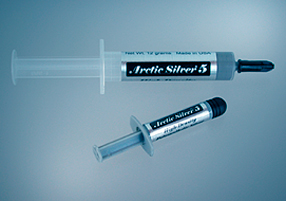Arctic Silver 5 is the successor of Arctic Silver 3. Why 5 and not 4? Well Japan is one of the biggest markets for Arctic Silver, and the number 4 is associated with death in Japan. Because they did not want the Japanese to associate this new thermal compound with dead hardware they called it Arctic Silver 5. Seems logical. It is sold in 3.5gram and 12 gram tubes. With the 3.5gram tube you should be able to cover 15 to 25 small cpu cores (like the AMD Athlon XP's) or 6 to 10 large CPU cores like the Pentium 4 and Athlon 64's. At a layer 0.003" thick, the 3.5 gram tube will cover approximately 16 square inches. These Norwegian already published a review in which they tested the Arctic Silver 5 against AS3 and Shin Etsu G-751.
Made with 99.9% pure micronized silver
Arctic Silver 5 uses three unique shapes and sizes of pure silver particles to maximize particle-to-particle contact area and thermal transfer.
Over 88% thermally conductive content by weight
Arctic Silver 5 also contains micron-ized zinc oxide, aluminum oxide and boron nitride in addition to the silver. These thermally-enhanced ceramic particles improve the compound's performance and long-term stability.
Controlled triple phase viscosity
Arctic Silver 5 does not contain any silicone. The suspension fluid is a proprietary mixture of advanced polysynthetic oils that work together to provide three distinctive functional phases. As it comes from the tube, Arctic Silver 5's consistency is engineered for easy application. During the CPU's initial use, the compound thins out to enhance the filling of the microscopic valleys and ensure the best physical contact between the heatsink and the CPU core. Then the compound thickens slightly over the next 50 to 200 hours of use to its final consistency designed for long-term stability.

| Specifications and Features | |
| Thermal Conductance | >30 x104 W/m2.°C (0.001 inch layer) |
| Thermal Resistance | <0.005°C-in2/Watt (0.001 inch layer) |
| Average particle size | <0.49 microns <0.000020 inch |
| Extended temperature limits | Peak: –50°C to >180°C Long-Term: –50°C to 130°C |